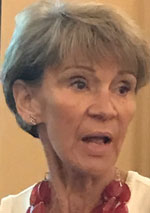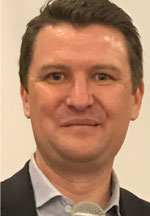Blog
MSU Gurus Inspire Operators To Put Customer Innovation Into Action
NASHVILLE -- The National Automatic Merchandising Association presented a half-day session through its Michigan State University executive leadership program during BLAST, titled "Your CIA: Customer Innovation in Action." MSU professor of communication Bonnie Knutson and MSU associate professor of marketing Clay Voorhees teamed up to inspire blind vending operators with new ways to improve communication, customer service, creativity and the bottom line in a complex consumer landscape with diverse demands...
November 16, 2017 by Emily Jed
NASHVILLE -- The National Automatic Merchandising Association presented a half-day session through its Michigan State University executive leadership program during BLAST, titled "Your CIA: Customer Innovation in Action." MSU professor of communication Bonnie Knutson and MSU associate professor of marketing Clay Voorhees teamed up to inspire blind vending operators with new ways to improve communication, customer service, creativity and the bottom line in a complex consumer landscape with diverse demands.
 Bonnie Knutson |
She observed that for the first time in history, five generations are living at the same time: Mature, Boomers, Gen X, Gen Y and I Gen, which is the "Internet" generation just graduating from college. "They're all consuming and they're all coming to you -- and you have to think about all of them," Knutson stressed.
Another important factor for operators to keep in mind is that today's population is increasingly mobile. "You just get them trained to be your customers and your employees, and then they move," she remarked. "I don't have a single hand that goes up when I ask my students who plans to stay in their home town. College graduates are expected to have 11 jobs before they retire. You need two marketing plans: one out the front door for your customers, and one out the back door for your employees. They move jobs to step up."
Connecting with customers on a personal level is critical in today's environment, driven by a resurgence of the importance of family, according to Knutson. The MSU professor added that the definition of family has changed from the traditional sense to the notion of connectivity.
"People need to connect, but they can have online 'family' closer than blood," she explained. "Starbucks and Disney have an emotional connection with their customers; you need to build that with yours."
Knutson emphasized the power of online communication, which has made businesses lose control of their own brand message and put it in the hands of their customers, for better or worse.
Through technology, she added, all five generations today are melding into a single generation: Generation C, united in their desire for choice, connectivity, community, customization, control and things being clear and compelling, among other expectations.
"Your customer wants a voice in your operation," the MSU professor stated. "If you don't give them an opportunity, the Internet will. Be exciting, fresh, innovative, powerful, relevant, and give them a little something extra: the unexpected. Look for ideas outside the industry to give you a new story. People will pay more for more unique and customized experiences. It can be challenging in vending but there are opportunities galore."
 Clay Voorhees |
Voorhees also advised blind entrepreneurs to "map" their customers' journeys by first identifying their target consumers and their varied expectations. The next step in the process is assessing their prior behavior patterns. "How has their day gone? What state are they in? Are they looking for just a caffeine injection or more? You want to find their underlying needs," the speaker advised.
The way to do this, Voorhees explained, is to talk directly with customers with the goal of finding the answer to "five whys." "It's hard to talk to your customers, but the key is to ask questions like 'Why are you so busy?' and then ask another 'why,' and another, to find out what's driving them," he explained. "You want it to get awkward, so you can find out how they're wired and connected. It makes you vulnerable, but it gets you to know how you can change to meet their needs."
The MSU marketing expert also advised operators to shop the competition. "Where are they good and bad? And put on the lens of your younger and older consumers and get ideas outside our industry," he recommended. "Benchmark your competitors and go above what they're delivering."
The "moments of truth" then validate that the operator fully understands and is most effectively engaging the customer. "Will they go out of their way to do business with you? Would they defend your organization if someone spoke out against it?" Voorhees instanced.
Voorhees encouraged operators to foster a culture for innovation within their businesses, where everyone's ideas count. "Listen to customers and employees for ideas. Innovate around your most critical customer segments, and you may find you grow out of others in the process. Keep it tight and simple and change one thing at a time," he suggested. "Celebrate innovation wins, but make it OK if they fail. And if you fail with a smile on your face, your customers will see it as a miss but appreciate the effort."







